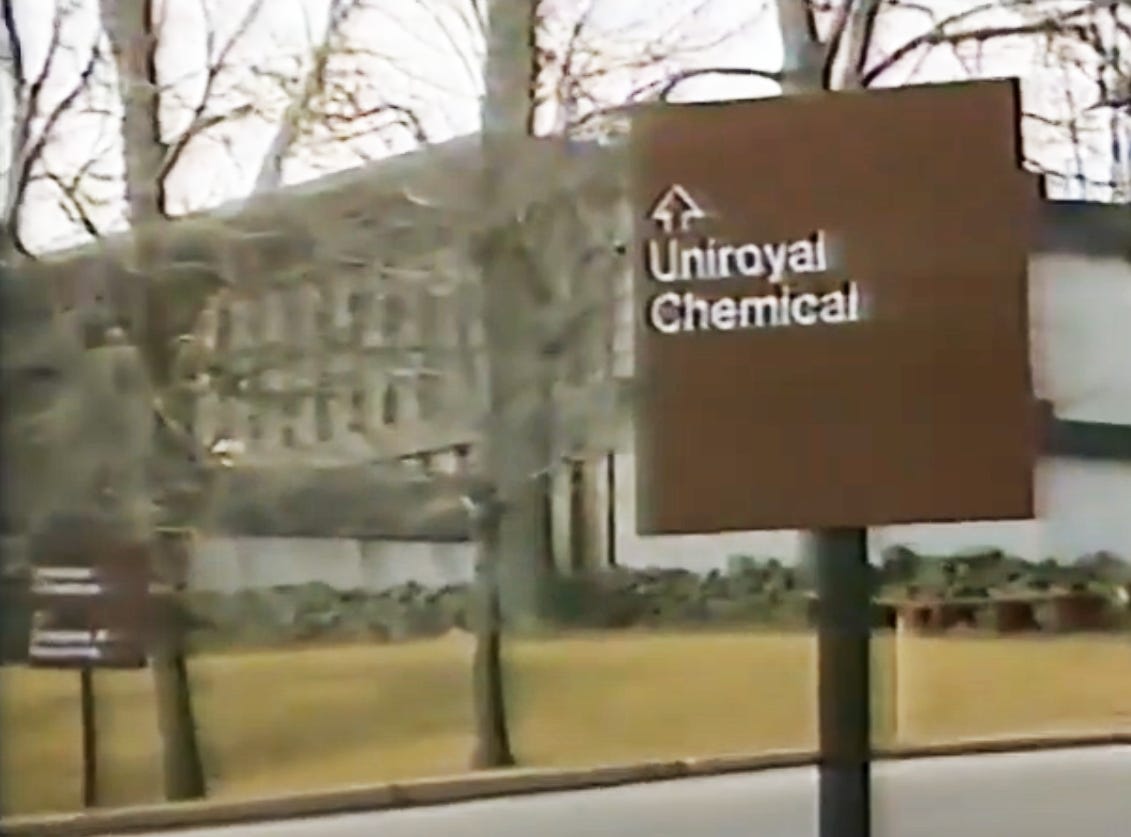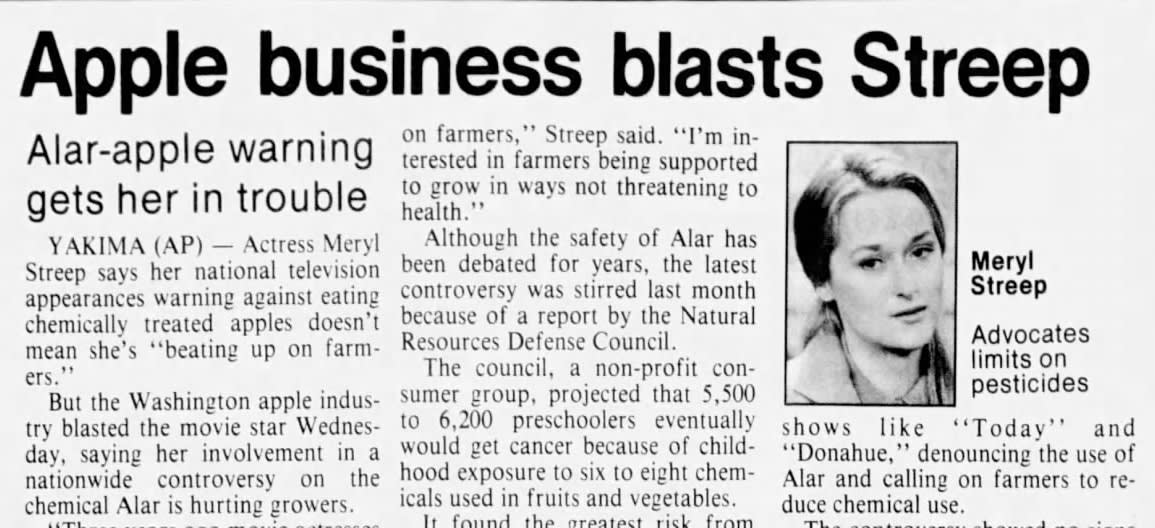Fright cocktail, part 1: Shoddy Goods 045
2Hey, I’m Jason Toon, and in this issue we’re telling a story too big for just this issue. Welcome to part 1 of the first-ever two-part story in Shoddy Goods, the newsletter from Meh about the stories behind consumer culture. If you read a newspaper or watched a Johnny Carson monologue in spring 1989, you definitely heard about what’s in this week’s edition…
OK, I’m not all that old. But I can remember a time when it was a novel, even radical idea that there were dangerous chemicals in our food, kept secret by big-money interests who cared more about their profits than the public good. When did that change? When did that suspicion start going mainstream?
You can pinpoint one major turning point specifically to a few weeks in early 1989. Two stories broke that did to trust in the food system what Watergate did to trust in government. It turned out there wasn’t much substance to either one. But the American public would never look at the produce section quite the same way.

60 Minutes is how long you’ll have to live if you eat that terrifying death apple. Click to watch.
A bunch of bad apples ruins the profit margin
Ever been apple picking? You know a lot of apples fall onto the ground before they can be picked. Some of them aren’t even ripe. And if you’re a big agribusiness corporation who owns, like, a million apple trees, that adds up. So, with the spray-chemicals-first, ask-questions-later mentality of midcentury corporate America, the Uniroyal Chemical Company registered a chemical called daminozide in 1963, which inhibits fruit and flower development in trees.
Under the brand name Alar, this powdery compound was used by growers to keep some apples on the trees until they were ripe. It also helps keep them firmer and redder (it was only used on red apple varieties), and gives them a longer shelf life.
Another trick daminozide does: when eaten by mammals, one of the chemicals it breaks down into is unsymmetrical dimethylhydrazine (UDMH), which showed links with cancerous tumors in lab mice in studies starting in 1967.
That much is settled fact. The next couple of decades saw a running three-cornered battle over how to interpret those facts. Activists like Ralph Nader charged that a corrupted Environmental Protection Agency was being far too lax in protecting the public from a dangerous carcinogen. The apple and chemical industries countered that the studies subjected mice to concentrations of daminozide many times higher than any person would ever ingest, well beyond the “maximum tolerated dose” that causes poisoning by even a benign substance. The EPA waffled, generally saying the evidence wasn’t clear enough to take Alar off the market.
Public opinion was less equivocal. Rachel Carson’s 1962 book Silent Spring had started a movement that eventually led to the banning of DDT and other chemical pesticides. The idea of apples dusted with Alar, while not a pesticide, wasn’t a great look for stores and apple processors (who make apple juice, applesauce, etc.). By 1986 most had voluntarily agreed not to use Alar-treated apples. But this debate mostly played out in the arcane hallways and hearing rooms of the regulatory system, without much attention from the general population. Alar still wasn’t exactly a household word.
Then one Sunday evening, all that changed.

If you see this view of your company on 60 Minutes, call a lawyer.
Putting the “Alar” in “alarming”
“The most potent cancer-causing agent in our food supply is a substance sprayed on apples to keep them on the trees longer and make them look better,” intoned Ed Bradley, one of the grey eminences of CBS-TV’s 60 Minutes, before a backdrop of a giant apple with a skull and crossbones etched into it.
It was February 26, 1989, and the story was an advance look at a National Resources Defense Council report officially set to release the following day. Over the next 12 minutes on the most-watched news program in America, Bradley quizzed an EPA official as to whether Alar would be approved today (no); explained why UDMH was a particular threat to kids (they drink so much apple juice); and heard from Janet Hathaway of the NRDC that 1 in 4,000 kids could expect to get cancer from the eight agricultural chemicals covered in their report (not, it should be noted, just from Alar or daminozide itself).
Toward the end of the segment, Bradley noted that most companies who processed or sold apples already claimed to not use daminozide-treated apples, and that there was less of it in circulation than a few years prior. But then a Consumers Union researcher told him that of apple products from 32 companies that claimed to be daminozide-free, 23 tested positive for some amount of the chemical.
“It’s supermarket roulette,” said the scientist, Dr. Ned Groth. “The consumer can’t tell by looking at the [juice] bottle whether it’s got daminozide in it. And unfortunately, the consumer can’t tell by depending on the manufacturer’s assurance.”
So, according to this story: the deadliest chemical in our food supply, particularly lethal to children, widespread and undetectable. You’d expect a panic to follow. And it did.
Schools around the country banned all apple products, including the green apples that had never been treated with Alar. A possibly apocryphal story had a terrified Oregon mom call state troopers to run down her child’s school bus so they could retrieve the menacing apple that she had accidentally packed in the kid’s school lunch.

Streep vs. apple growers: the conflict that tore America apart.
Phil Donahue told audiences “we’re poisoning our kids” with Alar. Apple sales fell by 60% across the board, including from producers in states that had banned Alar years previously. Apple growers’ industry groups sued whoever they could think of to blame, from the NRDC and 60 Minutes to outspoken anti-Alar activist Meryl Streep.
I can imagine recently sworn-in president George H.W. Bush commanding his subordinates to make this go away before he got blamed for kids getting cancer. By May, the EPA announced the preliminary steps to banning daminozide. Uniroyal, reading the writing on the wall, voluntarily discontinued Alar instead.
So… was the threat real? Look, analyzing the validity of the NRDC’s scientific claims, and opponents’ counter-claims, is beyond me. But the level of panic, of hysterically avoiding all kinds of apple products, certainly seems over-the-top. For 60 Minutes to show b-roll of a children’s cancer ward in their story, when almost definitely none of those kids’ cancers had anything to do with Alar, certainly seems sensationalistic. All this for a chemical that was only used on a single-digit percentage of apples, and had been for twenty years with no apparent ill effects?
That said: Alar wasn’t really doing anything that important, either. It was shown to cause cancers at some level in lab animals. Even if the risk is one excess cancer death in a hundred million people, it seems worth avoiding, balanced against Alar’s negligible benefits. The apple industry’s ease in adjusting to life after Alar showed that it wasn’t essential.
The outcome seems fine to me. But as we’ll see, the cultural echoes of the Alar scare would prove to have more impact than the chemical itself.
Meanwhile, way down in Santiago, Chile, the U.S. embassy got a phone call. The anonymous caller said he had injected cyanide into some grapes bound for the United States…
Continued next week in part 2

The guardians of consensus reality agree: EVERYBODY FREAK OUT RIGHT NOW
Food scares seemed like a huge thing in the 80s. Not legitimate recalls and outbreaks, but more “did you know this thing could actually kill you!?” stories.
Remember any good outlandish exposés or scares that turned out to be basically nothing? Let’s hear about ‘em in this week’s Shoddy Goods chat.
—Dave (and the rest of Meh)
The only chemical these past articles have been treated with is love:
- 6 comments, 21 replies
- Comment
At least it was a somewhat functional EPA
Recently the news feeds keep reporting that “RICE IS DANGEROUS!” First it was reheating rice could lead to high levels of bacteria. Now it’s rice has high levels of arsenic. And yet millions of people worldwide eat and reheat rice and we’re not really hearing about a lot of rice-related deaths. So …
@Kyeh CHINESE BUFFET RESTAURANTS WILL KILL YOU. Also, you can now make your own digestion-resistant fiber by letting cooked rice congeal in the fridge overnight.
@mossygreen Yes, but don’t reheat it -
@Kyeh @mossygreen I looked into the rice thing several years ago when I was considering making a rice salad for a outdoor dinner. I read lots of articles from questionable sources, e.g., “wellness” sites, and reputable sources, e.g., university medical schools and research facilities. The bottom line is that rice is an excellent growing medium for bacteria, specifically Bacillus cereus, which can and does exist in rice in spore form which is heat resistant. To keep the spores from germinated and producing a toxin, rice must be kept at 40F and below or 140F and above. Room temperature, as at an outdoor dinner or picnic, is a bad idea, i.e., don’t bring a rice dish to a potluck. Reheating rice is ok provided it wasn’t in the danger zone and was cooled quickly and kept cool. Cooked rice is generally safe for up to five days in a fridge.
@Kyeh @mossygreen i read that article too. “you don’t have to eat i cold but only gently reheat it” is so unclear. i think i’ll be getting my fiber/slow digesting carbs elsewhere
@ItalianScallion @Kyeh @mossygreen
This is why my neighbors had a compromise: scoop out your rice serving from that 50 lb crate into a Ziploc bag and freeze it overnight before cooking it
@Kyeh @mossygreen @pakopako It’s not clear if overnight freezing is enough to inactivate the Bacillus cereus spores commonly found in rice. I just read part of a few reports and they concur that it takes about four days of isochoric freezing (constant volume based) at -15degC/4degF to inactivate the spores. Regular freezing doesn’t accomplish that.
@ItalianScallion @mossygreen @pakopako I’m just going to carry on as I have for years. This sounds like another passing freakout to me.

@ItalianScallion @Kyeh @mossygreen @pakopako What doesn’t kill you makes you stronger.
Oh yeah - MSG!!! That was such a misleading and exaggerated panic, that still persists today.
https://www.sciencehistory.org/stories/magazine/the-rotten-science-behind-the-msg-scare/
MSG is often associated with Asian food. Rice is a staple in Asian cooking. Years ago I read from a reliable source (I think, but it was long ago) that it isn’t MSG that makes people sick, but rather improper handling of rice in restaurant kitchens. It wasn’t being kept out of the 40F to 140F danger zone (see my comment to @Kyeh’s rice is dangerous comment), which included both leftover rice from one day being used to make fried rice the next day and fresh rice. An allergy to MSG is nowhere near as widespread as has been alleged.
@ItalianScallion I think the MSG thing was overhyped hysteria and xenophobia.
The rice thing’s been researched extensively, yet I still haven’t heard a lot about people getting sick from rice. I’m not super cautious with my rice and haven’t had problems from it.
the prompt reminds me of checking your kid’s halloween candy for poison, crack, and razorblades
@sagergen And don’t forget to check your Tylenol bottles for pinholes!
@sagergen And the temporary tattoos for LSD
@dave @sagergen
I can remember a time when we would routinely do free x-ray scans of Halloween candy bags on Halloween night got the ER I worked in.
@sagergen I can’t believe we went from fearing about syringes in candy to asking for them
https://pbfcomics.com/comics/the-treat/
Of course, coffee is good, then bad, then good for you; also red wine, currently out of favor …
@Kyeh Red wine? Out of favor? Not in this house. I’m going to open a bottle right now to be defiant.
@ItalianScallion Yeah, I don’t think too many people are convinced that it’s bad for them!
Red meat, margarine, portion control, sugar
@Star2236 Oh, yeah - margarine - I’m so glad they decided that butter is healthier!
@Kyeh
My dad still bought it, the spreadable kind. I do have a recipe that my dad gave me (cheesy potatoes) and it calls for a stick of ollio (margarine) melted on top of it and o do stay true to the recipe for that bc his cheesy potatoes were always the bomb. Mine never taste as good.
@Kyeh @Star2236 My mom used to buy the kind of margarine that came with a yellow coloring packet that you mixed into the margarine stick. At that time, you weren’t allowed to sell margarine that was yellow, I think it’s because the dairy lobby didn’t want margarine to be confused with butter.
@Star2236 Yeah, sometimes you just have to stick with the classic ingredients for a beloved recipe.
@ItalianScallion What a hassle!
@ItalianScallion @Kyeh
I read that, why I was reading about margarine I don’t know.